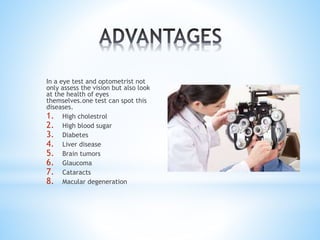The Duty of Advanced Diagnostic Devices in Identifying Eye Disorders
In the world of ophthalmology, the use of advanced diagnostic tools has transformed the very early identification and monitoring of different eye problems. As the need for precise and prompt diagnoses continues to expand, the integration of sophisticated devices like optical coherence tomography and aesthetic field testing has become important in the world of eye care.
Relevance of Early Diagnosis
Very early diagnosis plays a critical function in the effective administration and therapy of eye conditions. Prompt recognition of eye conditions is vital as it enables prompt intervention, possibly avoiding further development of the condition and minimizing long-term difficulties. By detecting eye disorders at an onset, health care companies can provide ideal therapy plans customized to the details problem, inevitably bring about better end results for individuals. Early diagnosis enables people to gain access to necessary assistance solutions and sources sooner, enhancing their general high quality of life.

Innovation for Identifying Glaucoma
Sophisticated diagnostic innovations play an essential duty in the very early detection and monitoring of glaucoma, a leading reason for irreparable blindness worldwide. One such technology is optical comprehensibility tomography (OCT), which provides comprehensive cross-sectional pictures of the retina, permitting the measurement of retinal nerve fiber layer thickness. This dimension is crucial in assessing damages triggered by glaucoma. One more advanced device is aesthetic field screening, which maps the level of sensitivity of a person's visual area, aiding to discover any areas of vision loss feature of glaucoma. In addition, tonometry is used to gauge intraocular pressure, a significant danger element for glaucoma. This test is important as elevated intraocular stress can bring about optic nerve damages. Moreover, more recent modern technologies like the usage of man-made knowledge algorithms in analyzing imaging information are showing promising outcomes in the early discovery of glaucoma. These advanced analysis devices allow ophthalmologists to detect glaucoma in its beginning, enabling timely treatment and better monitoring of the disease to avoid vision loss.
Duty of Optical Coherence Tomography

OCT's capability to quantify retinal nerve fiber layer density permits for specific and unbiased measurements, aiding in the early discovery of glaucoma also before visual field issues emerge. Moreover, OCT innovation allows longitudinal monitoring of architectural changes with time, helping with personalized therapy plans and prompt treatments to aid maintain individuals' vision. The non-invasive nature of OCT imaging also makes it a recommended choice for checking glaucoma progression, as it can be duplicated regularly without triggering discomfort to the client. On the whole, OCT plays a vital duty in improving the analysis accuracy and monitoring of glaucoma, eventually contributing to much better end results for people at danger of vision loss.
Enhancing Diagnosis With Visual Area Testing
An essential component in extensive sensory evaluations, aesthetic area testing plays a critical function in enhancing the diagnostic process More Info for numerous eye disorders. By assessing the complete extent of a client's aesthetic field, this examination provides essential info about the practical honesty of the whole visual pathway, from the retina to the visual cortex.
Aesthetic area screening is specifically useful in the diagnosis and monitoring of problems such as glaucoma, optic nerve conditions, and various neurological conditions that can impact vision. With quantitative dimensions of outer and main vision, clinicians can identify subtle changes that might indicate the existence or progression of these problems, even before noticeable signs and symptoms take place.
Additionally, visual area testing permits for the tracking of treatment efficiency, aiding eye doctors customize restorative interventions to individual patients. eyecare near me. By tracking changes in visual area performance with time, health care providers can make informed decisions about adjusting drugs, suggesting surgical treatments, or applying various other appropriate actions to protect or improve a patient's visual feature
Managing Macular Deterioration

Verdict
In final thought, progressed analysis tools play a crucial function in determining eye disorders early on. Technologies such as Optical Comprehensibility Tomography and visual area screening have substantially enhanced the accuracy and effectiveness of identifying conditions like glaucoma and macular degeneration.